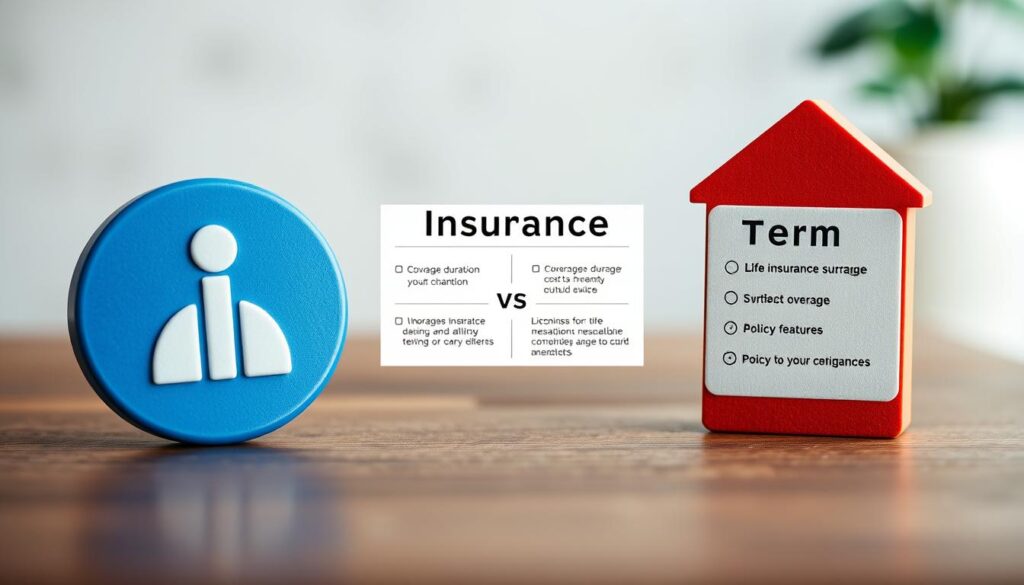Choosing the right coverage starts with understanding how each option protects your family. This guide compares the two main approaches under the life insurance umbrella and explains who each serves best.
Term coverage usually covers a set period—often 10 to 30 years—and generally costs less up front. If a qualifying event happens during that time, the carrier pays a death benefit that supports loved ones.
Permanent coverage lasts as long as premiums are paid and often includes a tax-deferred cash component that can be borrowed against. That added feature raises costs but can offer long-term financial flexibility.
There’s no one-size-fits-all answer. The best choice depends on your budget, how long you want protection, and your broader financial goals. Later sections will compare coverage, premiums, cash features, underwriting, and conversion options so you can match a plan to your stage in life.
Key Takeaways
- Understand that the umbrella term includes both term and permanent structures.
- Term is cost-effective for fixed time needs; permanent adds lasting protection and savings features.
- The core promise is a death benefit that helps replace income or pay debts for loved ones.
- Some term plans allow conversion to permanent coverage without new health exams.
- Pick based on budget, protection length, and long-term financial goals.
Understanding the decision today: coverage, costs, and your financial goals
Decide first what financial goals matter most, then choose coverage that fits that timeline.
Start by listing your goals: replace income, pay a mortgage, fund college, or leave a legacy. Then estimate how much you need coverage and for how long.
Term life insurance often gives an affordable, straightforward safety net for fixed periods tied to milestones like a mortgage or years raising kids. It usually costs less up front and matches clearly to short- to mid-term needs.
Whole life insurance keeps protection in force for life and includes a savings-like component that grows tax-deferred. That makes it a fit when you want lifetime certainty and an accumulating account alongside protection.
Underwriting rules differ: medical exams are common for term life insurance, while some final-expense whole life policies may waive exams. Compare monthly affordability against the certainty of lifelong coverage.
“Match coverage to your plan, not the other way around.”
- Check how much a policy covers relative to debts and income replacement.
- Compare insurer ratings and conversion features before you buy.
- Think decades ahead—evaluate total costs, not just the first-year premium.
What is term life insurance and how does it work?
Term policies give fixed-period protection that matches short- and mid‑stage financial needs. A term life insurance plan covers you for a stated number of years—commonly 10, 20, or 30—and pays a death benefit if the insured dies during that time.
How the process works:
- Decide how much coverage you need using a calculator or advisor to align benefit amounts with income replacement and debts.
- Apply by submitting ID, proof of income, and beneficiary names. Underwriting may include a medical exam.
- When issued, the policy shows the term length, level-premium period, death benefit, and any riders or a conversion option.
End-of-term choices and trade-offs:
- Let the policy lapse, renew at higher, age-rated premiums, or convert to a permanent plan within the conversion window without a new exam.
- Major benefits are affordability and simplicity—higher coverage for lower costs and minimal complexity.
- Limits include no payout if you outlive the term, no cash value to borrow against, and rising renewal premiums.
Common fits: young parents on a 30-year mortgage, a 45-year-old with teens choosing a 10-year plan, or business owners protecting a key employee. Evaluate riders like accelerated death benefit and confirm conversion deadlines to keep future flexibility.
What is whole life insurance and how does it work?
Whole life plans combine permanent protection with a predictable premium schedule and an accumulating cash account.
Definition and guarantees
Whole life insurance is a form of permanent life insurance designed to last your entire life, as long as you keep paying premiums. It provides a guaranteed death benefit that pays to beneficiaries and helps cover final costs or leave a legacy for loved ones.
Cash value component: growth and access
A portion of each premium builds a tax-deferred cash value component. That cash can be borrowed against or withdrawn, though outstanding loans may reduce the death benefit.
Loans accrue interest and withdrawals can have tax consequences; consult a tax professional before accessing funds.
Premiums, stability, and dividends
Premiums are level and predictable, so budgeting is easier over time. Some policies from mutual insurance companies may pay dividends that you can take in cash, use to cut premiums, or reinvest as paid-up additions.
Pros and cons to weigh
- Pros: lifelong coverage, guaranteed death benefit, build cash value, potential dividends, predictable premiums.
- Cons: higher premiums than term options, lower flexibility than some other permanent products, and returns tied to insurer performance and guarantees.
“Whole life is best when you need guaranteed lifetime coverage and a steady cash reserve for future needs.”
Life Insurance vs Term Insurance: key differences that matter
The core difference is simple: one option provides protection for a set period while the other maintains coverage for life. That distinction affects cost, flexibility, and how the policy fits into financial plans.
Coverage duration: term expiration vs. lifelong protection
Term plans end when the stated period expires unless you renew or convert. Renewal premiums often rise with age.
Whole life stays in force as long as premiums are paid and guarantees a death benefit for beneficiaries.
Premiums and total costs: affordability, fixed rates, and renewals
Term usually costs less up front, making it attractive for short needs. However, renewing can cause steep premium increases.
Whole life charges higher but fixed premiums. Over decades, those steady payments buy guaranteed coverage and predictability.
Cash value and investment features
Term policies do not build a cash value component. You get only the death benefit during the covered period.
Whole life accumulates a tax-deferred value component that can be borrowed against or withdrawn, reducing the death payout if not repaid.
Underwriting and flexibility: exams, conversions, and policy changes
Term often requires medical underwriting. Some whole life final-expense products use simplified or guaranteed issue underwriting.
Many term contracts offer a conversion window so you can switch to whole life without new exams. Whole life allows policy loans and certain adjustments, though it is less flexible than some other permanent products.
“Read provisions carefully: riders, conversion deadlines, surrender values, and loan terms change how a policy performs over time.”
| Feature | Term Option | Whole Life Option | When to Choose |
|---|---|---|---|
| Coverage Length | Fixed years (10–30) | Lifetime while premiums paid | Short-term needs vs. lifelong certainty |
| Premiums | Lower initially; rise on renewal | Higher but level for life | Budget-conscious vs. predictable budgeting |
| Cash/Value | No cash value component | Builds tax-deferred cash value | Pure protection vs. protection plus savings |
| Underwriting & Flex | Medical exams common; conversion possible | Simplified issue options exist; loans allowed | Temporary coverage with conversion vs. permanent planning |

Which policy fits your needs? Match coverage to goals, budget, and timeline
Match the type of protection to the risks you face today and the financial goals you want to meet. Start by defining the horizon for your main needs: short-term debt, years of income replacement, or a lifetime need for proceeds.
Income replacement, mortgages, and raising kids: when term life shines
Term life insurance is ideal when you need focused protection for a known period. Use it to cover a 30-year mortgage, bridge child-rearing years, or replace income during peak earning years.
Practical cues: choose 10-, 20-, or 30-year lengths based on mortgage remaining, ages of dependents, and your planned retirement date. This helps avoid paying for coverage you no longer need.
Estate planning, final expenses, and legacy goals: when whole life fits
Whole life insurance works when you need guarantees and a permanent death benefit. It can fund final expenses, provide estate liquidity, or preserve a legacy without timing risk.
A whole life policy also builds tax-deferred cash value that can be accessed for trusts or to equalize inheritances among heirs.
Special cases: business owners, key person needs, and buy-sell funding
Business owners often mix approaches: a term plan can protect early-stage growth and key-person risk, while a permanent life policy can fund buy-sell agreements that must be ready at any time.
Long-term care riders and supporting a disabled dependent
Some permanent contracts add long-term care riders that advance part of the death benefit for qualified care. A whole life policy can also be structured into trusts to support a disabled dependent safely.
Beyond term and whole: permanent life insurance alternatives
Permanent products vary widely—some prioritize guarantees while others tie cash growth to market returns. Each option keeps a death benefit in force when policy charges are met, yet they differ in flexibility, risk, and how the cash value component grows.
Universal: flexible premiums with minimum crediting
Universal allows adjustable premiums and flexible death benefit options. The insurer credits interest based on current assumptions and usually guarantees a minimum rate.
This design requires monitoring to avoid lapses when charges exceed contributions.
Indexed universal: market-linked crediting, with limits
Indexed universal credits interest tied to an external index (for example, S&P 500). It often has a 0% floor plus caps or participation rates that limit upside.
The floor protects against negative returns while caps or participation rates reduce how much you can build cash during strong markets.
Variable universal: sub-accounts and active management
Variable universal places the cash value into investment sub-accounts similar to mutual funds. That offers higher return potential but also greater volatility.
Policyholders must actively manage allocations and accept that sub-account performance directly affects the value component and long-term coverage costs.
“Match product type to your risk tolerance, time horizon, and willingness to manage the policy.”
- Build cash value potential is greatest in variable designs but more volatile.
- Indexed designs balance upside with downside protection via floors and caps.
- Universal plans offer the most flexibility with minimum guaranteed crediting.
- Business owners may use permanent structures for executive benefits or retention plans.
Cost realities today: premiums, value components, and long-run trade-offs
Today’s pricing shows a clear trade-off: lower near-term premiums or higher, steady payments that build value.
What drives premiums: age, health, term length, and death benefit
Underwriters set rates using age, health, tobacco use, gender, and the face amount. Longer terms and larger coverage raise costs.
Upfront term pricing is usually lower because there is no cash accumulation. Renewals later can create an expensive term life scenario if you still need protection at older ages.
Paying more for permanence: building cash value vs. buying more coverage
Whole life and similar permanent products charge higher, fixed premiums to fund a guaranteed death payout and a tax-deferred cash account.
This cash can be borrowed or withdrawn, but loans reduce the death payout and may incur charges. Compare paying more to build a lifelong asset versus buying additional term coverage to maximize protection today.
- Review total lifetime costs, surrender values, and internal rates of return—not only first-year premiums.
- Underwriting class, riders, and face amount choices affect final pricing; improve health to lower rates.
- Get multiple quotes and check insurer ratings before committing to any policy.
Smart strategies to choose confidently
Mixing short-term protection with a small permanent hold can give both affordability and lasting certainty.
Use laddering to match changing needs
Laddering means buying multiple term contracts with staggered end dates so coverage steps down as debts fall and kids grow independent.
This approach can lower your total spend versus one big, long contract while keeping needed protection at each stage.
Convert part of your coverage when goals shift
Many term plans allow you to convert some or all coverage to a permanent life contract without a new exam during a conversion window.
Consider converting a portion when income rises or when you need a permanent life insurance piece for estate or special-needs planning.

“Review conversion deadlines early and read rider language closely — fees and limits affect practical choices.”
Coordinate a core term plan for income replacement plus a small permanent life holding to balance cost and guarantees.
Review your life policy every few years, read the fine print on riders and fees, and consult a licensed professional to compare illustrations and confirm the right choice for your broader financial plan.
Conclusion
Match your priorities—budget, duration, and future plans—before committing to a policy.
Both whole life and term life offer clear advantages depending on needs. Use term life insurance for affordable, simple protection during defined years like a mortgage or child-rearing period. Choose whole life insurance when you want guaranteed lifelong coverage, fixed premiums, and an accumulating value component for legacy planning.
Weigh total premiums, conversion options, and payout certainty when you compare illustrations. Review insurer strength and the mix of guaranteed and non‑guaranteed elements in life insurance policies.
Define financial goals, estimate coverage for your loved ones, compare quotes, and consider professional guidance to make an informed choice you will keep.
FAQ
What’s the main difference between term and whole policies?
Term covers you for a fixed period and pays a death benefit if you die during that term. Whole provides lifelong coverage and builds a cash value component you can borrow against or withdraw.
When should I pick a fixed-term policy?
Choose a fixed-term plan to replace income, cover a mortgage, or protect children while costs are time-limited. It’s typically more affordable up front and good when you only need coverage for a specific time frame.
Who benefits most from a permanent policy with cash value?
People focused on estate planning, paying final expenses, or building a tax-deferred cash reserve often favor permanent options. Business owners who need buy-sell funding or key-person protection also use these products.
How do premiums compare between the two types?
Fixed-term premiums start lower but rise on renewal or stop when the term ends. Permanent premiums are higher and level over time because they fund lifetime coverage and the cash value component.
Can I convert a term contract to a permanent one?
Many carriers allow conversion without new medical underwriting within a set window. This preserves insurability and can be a smart move if health changes or you want lifetime coverage later.
What is the cash value and how can I use it?
Cash value is a tax-deferred account inside permanent contracts that grows over time. You can take loans, make withdrawals, or use it to pay premiums. Loans reduce the death benefit if unpaid.
Are earnings inside cash value taxed?
Generally, cash value grows tax-deferred. Withdrawals up to basis are typically tax-free; loans are not taxable unless the policy lapses or is surrendered and gain is realized.
How does underwriting affect cost and availability?
Age, health, and lifestyle drive underwriting. Younger, healthier applicants get the best rates. High-risk health issues can make permanent options more expensive but conversion privileges help preserve coverage.
What are common strategies to manage cost and coverage needs?
Laddering multiple terms, buying a smaller permanent policy plus term riders, or using conversion options are common. Business owners often combine products to meet buy-sell or key-person goals.
How do riders and additional benefits change a policy?
Riders—like accelerated death benefits, long-term care, or disability waivers—add flexibility and cost. They can protect against specific risks and may be worth the added premium for some households.
If I’m on a tight budget, what’s the most practical choice?
A fixed-term plan usually gives the most coverage per dollar and is practical when needs are temporary. Reassess at major life events and consider conversion if you later want permanence.
Can policies be used for retirement planning or investments?
Permanent contracts with cash accumulation can supplement retirement savings, but they carry costs and complexity. Compare projected cash value growth to other investment vehicles before committing.
How do I match a policy to my financial goals?
Define needs (income replacement, final expenses, estate transfer), timeline, and budget. Short-term needs point to term; lifelong goals and cash accumulation point to permanent options. A licensed advisor can model scenarios.
What should business owners consider when choosing coverage?
Determine whether you need key-person protection, buy-sell funding, or debt coverage. Permanent plans can fund long-term obligations; term plans cover finite business loans and short-term risks.
Are indexed or variable permanent products better than traditional whole policies?
Indexed products credit interest based on market indexes with caps and floors, offering growth potential with limits. Variable options let you invest sub-accounts and carry more risk and reward. Evaluate fees, guarantees, and your risk tolerance.

